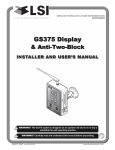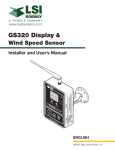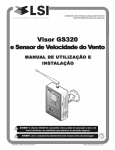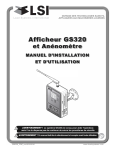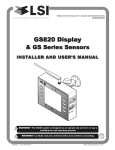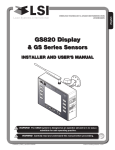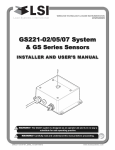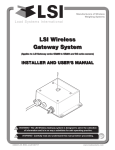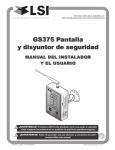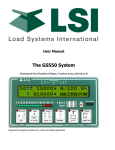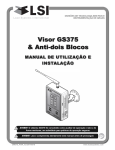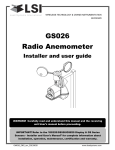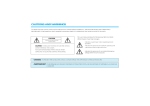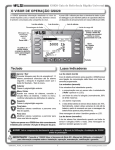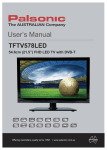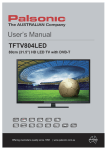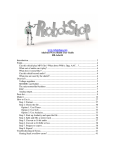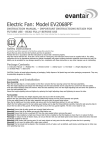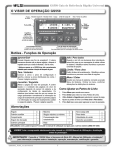Download Wind Speed Meter & Indicator Manual
Transcript
WIRELESS TECHNOLOGY & CRANE INSTRUMENTATION DIVISIONS GS320 Display & Wind Speed Sensor INSTALLER AND USER’S MANUAL ww w.l oa ds ystte ms .co m Lo Baw tt m/s Sta tus mp h Ala rm Se t Lim it GS 320 ! WARNING! ! Win dS pee d In dic ato r The GS320 system is designed as an operator aid and is in no way a substitute for safe operating practice. WARNING! Carefully read and understand this manual before proceeding. GM320_ENG_rev20110516 www.loadsystems.com BEFORE PROCEEDING Read and understand the following: For your safety and that of the people that come into contact with LSI products, understand the significance of the instructions included in this guide, respect all laws and regulations and comply with applicable standards. Pay particular attention to items bearing the alert symbol ! and the following words: ! WARNING! Warning: this denotes an instruction that if not complied with may lead to serious injury or death. ! CAUTION! Caution: this denotes an instruction that if not complied with may lead to product failure or property damage. ! IMPORTANT! Important: this denotes an instruction that if not complied with may lead to product performance issues. ! WARNING! Installation must be made in compliance with LSI instructions and using LSI supplied components only. Failure to install all parts, or replacing parts or components with parts or components not supplied by LSI , may lead to system failure, serious injury or death. 2 The GS320 System TABLE OF CONTENTS 1. INTRODUCTION 1.1 OVERVIEW ........................................4 1.2 START-UP ..........................................4 1.3 RECOMMENDED OPERATING CONDITIONS ....................................4 2. INSTALLATION 2.1 DISPLAY GS320 ................................5 2.1a Mounting Bracket ........................................5 2.1b Antenna Position ........................................6 2.1c Power Supply and Lockout Connection ......6 2.2 WIRELESS WIND SPEED SENSOR GS020 ................................................7 3. OPERATION 3.1 UNITS ................................................8 3.2 ALARM THRESHOLD ......................8 3.3 LISTEN ONLY MODE ........................8 3.4 DISPLAY SETTINGS ........................8 5. CERTIFICATION NOTES 5.1 FCC AND IC – INSTRUCTIONS TO THE USER ......................................11 5.2 CE ....................................................12 5.2a Declaration of conformity ..........................12 5.2b CE Safety..................................................12 6. LSI PRODUCT LIMITED WARRANTY - 2009/02/16 6.1 LIMITED WARRANTY ....................13 6.2 WARRANTY SERVICES PROCEDURES ................................13 6.3 EXCLUSION OF OTHER WARRANTIES ................................13 6.4 EXCLUSION ....................................14 6.5 LIMITATION OF LIABILITY ............14 6.6 RECOMMENDED PRACTICES ......14 6.7 CHOICE OF LAW ............................14 6.7a Entire Agreement ......................................14 4. MAINTENANCE 4.1 REPLACING THE SENSOR BATTERY ..........................................9 4.2 REPLACING THE SENSOR ANTENNA........................................10 TABLE OF CONTENTS OPERATION 3 1. INTRODUCTION 1.1 Overview The wind speed indicator kit includes a GS320 display and a wind speed sensor. The GS320 creates a two-way radio network with the wind speed sensor to bring live readings on screen. The GS320 has a user adjustable maximum wind speed limit and will generate an alarm when this limit is reached. Furthermore, when in alarm voltage is generated on the green wire; this can be used to activate a remote siren, light or lockout function. 1.2 Start-Up On power up, the display will show two horizontal lines and the green status light will flash. Once a reliable radio communication network is established, the display lights will remain lit without flashing. If the status light flashes continuously for more than 30 seconds the GS320 may not be correctly programmed for the wind speed sensor. To correctly program the GS320 for the wind speed sensor follow the Wind speed ID number procedure in the Operation section of this manual. 1.3 Recommended Operating Conditions Supply voltage: 9 to 30 volts Current requirements: maximum 1 amperes Output wire voltage: 0 volts or supply voltage - 0.7 volts Output wire current capability: 0.75 amperes Operating temperature: -40°C to +85°C (-40°F to 185°F) 4 The GS320 System 2. INSTALLATION ! WARNING! Installation must be made in compliance with LSI instructions and using LSI supplied components only. Failure to install all parts, or replacing parts or components with parts or components not supplied by LSI , may lead to system failure, serious injury or death. 2.1 Display GS320 ! IMPORTANT! Do not crack or puncture the membrane fascia. The GS320 display is splash and rain proof. Waterproofing depends in part on the integrity of the membrane. IMPORTANT! Do not power wash the display. The GS320 display is not designed to withstand high-pressure washing devices that can erode the membrane fascia seal or create fissures in the membrane fascia. Power washing the display voids warranty coverage. reliable radio communication between wind speed sensor and the GS320, the antenna should not be in contact with metal and should have a direct and clear line of sight to the sensor antenna. The mounting bracket requires a flat surface of at least 2.5 inches in diameter on both sides and where the back of the surface is accessible in order to tighten the nuts. 2. Drill 1/4 inch boltholes through the mounting surface with a 1/4 inch bit following either the two, three, or the four holes configuration. 0.906 ø2.5 in. min. flat surface 0.594 0.594 ø0.218 120° TYP 0.750 0.750 Figure: Display mounting bracket footprint. Not to scale. Field replaceable antenna Part number: TA008 Rugged aluminium enclosure Two way radio system ww w.lo ad syst em s.co m Lo Baw tt m/s Sta tus mph Ala rm Se t Lim it GS 320 Waterproof design Win dS pee d In dic ato r Adjustable Ram-Bracket with dual ball joints. Part number: LB002B 3. Install the display with bolts. Add washers and lock nut behind the mounting surface and tighten sufficiently (bolts, nuts and washers not included). Note: If the nuts are on the outside of the cab, caulk with silicone between the washers and the cab to prevent water entry. 4. Loosen the wing nut of the bracket arm to adjust display orientation to facilitate viewing by the operator and then tighten it back up. Figure: Display GS320 1.37 Wing Nut www.loadsystems.com Low Batt m/s mph 4.70 4 .70 70 Status 6.19 2.44 Alarm Set Limit www. loads ystem s.com GS320 Wind Speed Indicator 8.83 3.70 Low Batt 2.20 m/s Figure: Display dimensions (inches). Not to scale. 2.1a Mounting Bracket 1. Determine the mounting location; the display may be installed either inside or outside the cab. It can be mounted on the dash, on a sidewall, or on the ceiling of the cab. To ensure INSTALLATION mph Stat 6.49 us Alarm Set Lim it GS3 20 Win d d Sp eed Indic ator Cab mounting surface Figure: Install the display and adjust orientation 5 2.1b Antenna Position For optimal performance the antenna should be positioned on its side such that it is parallel to the sensor antenna (but not pointing directly to or directly away from it). ← To GS320 To valve coil if normally open is required Bosch relay 1. Adjust the antenna position with the articulating base. 2. The antenna should have 5 inches of clear space all around it. 3. The antenna should have an unobstructed line of sight to all sensor antennas at all boom angles. 2.1c Power Supply and Lockout Connection 1. Connect the blue wire (ground) to the negative terminal of the battery or the panel connection; alternatively bolt the blue wire to the body of the machine with a 1/4 inch or 5/16 inch bolt. The ground connection must be strong enough to sustain 3 amperes. Green wire - Lockout n.c. Red wire n.o. Blue wire co Power Supply or Battery +12 V or +24 V To valve coil if normally closed is required Figure: Connection with green wire lockout and recommended Bosch relay. 2. Connect the red wire to a fused accessory source, rated at least 3 amperes, that supplies +12 or +24 volts when the machine is in use. The GS320 will automatically detect the voltage level and adjust itself. 3. Lockout wire (if required): connect the green wire to a Bosch relay coil terminal. Connect the other coil terminal of the relay to the ground. When in safe condition, the green wire will energize at the battery positive level. Current over 1 ampere on the green wire triggers an auto re-settable fuse. Current flow will resume several seconds after the short circuit is eliminated. Troubleshooting: if no voltage is present on the green wire remove the load connected to it. 6 The GS320 System 2.2 Wireless Wind Speed Sensor GS020 c. The wind cups must be fully exposed to the wind and spin freely at all boom angles. Mounting rod Figure: GS020 wireless wind speed sensor 1. Remove the mounting rod from the wind speed sensor. ! IMPORTANT! Do not weld in proximity to LSI sensor/transmitters. 2. Determine the mounting rod position. Figure: Wind clearance d. There should be a clear and unobstructed line of sight between the wind speed sensor antenna and the cabin mounted display unit. a. Install the mounting rod on the same side of the boom as the cabin mounted display, perpendicular to the boom, and at the highest point possible. b. The wind speed sensor must pivot freely on the mounting rod at all boom angles. Figure: Radio line of sight - Crane top view e. The transmitter antenna should not contact any metal object. Note: Angle iron can be used to extend the mounting position to be clear of the boom top. 3. Weld or screw the mounting rod to the boom at the selected position. Figure: Swivel orientation INSTALLATION 4. Re-position the wind speed sensor on the mounting rod, add the washer and secure with the cotter pin. 7 3. OPERATION 3.4 Display Settings www.loadsystems.com ww ww Low Batt m/s Battery light Units mph Status Alarm Alarm light Status light Set Limit GS320 Wind Speed Indicator 3.1 Units This section describes how to manually change the ID number the GS320 will listen to, and how to change some other behavior of this display. Changing the wind speed ID number is required only if the wind speed sensor is changed and the display must be manually set to listen to an other one. Press and hold the Up and Down buttons simultaneously for 5 seconds. The display will beep and then indicate the currently programmed wind speed sensor ID number, one digit at a time. The ID number must contain 6 digits, if the ID number is 120, the three first digits are “000”. 1. Press Set Limit button to change from one screen to the next. The GS320 indicates wind speed in miles per hour (mph) or metres per second (m/s). Current units are indicated by a small green light. 2. To change a digit, use the Up and Down buttons. To change units press and hold the Down button for 5 seconds. Verify the alarm threshold every time the current units are changed. “LA” means Listening Mode Active. Another GS320 dislay must be the master of the wind speed sensor. 3.2 Alarm Threshold Press the Set Limit button to see the alarm threshold. Every time the units are changed, the limit must be verified and re-adjusted if required. To change the limit, press and hold down the Set Limit button, and use the Up or Down buttons repeatedly to increase or lower the limit. 3.3 Listen Only Mode When the GS320 is started it wakes up the wind speed sensor programmed to it and takes control of the sensor. This means that if a second display is programmed for the sensor, it will take control of it; the sensor will no longer acknowledge communication from the first display. The GS320 can be programmed to operate in “listening mode”. In this mode the GS320 will display information from the programmed sensor without becoming the network controller. ! IMPORTANT! A sensor can only have one network controller at a time. To receive communication from a sensor without taking control of that sensor the display must first be programmed in “listening mode”. 8 “Ld” means Listening De-activated (default). Press Down to change to “LA”. “OS” means Output Standard: fail safe output (default). The output provides power when wind speed is safe, below the limit. Press Down to change to “OI”. “OI” means Output Inverted: the output wire is energized when wind speed is above the limit. This could be use to power an external siren or horn. “SA” means Save. When this screen is displayed, press the Down button to save the ID number and above options and then exit. “CA” means Cancel. Press the Down button to exit without saving. The system will retain the previously set ID number and options. Example: if the ID number is 18820, it will appear like this on the screen: Set Limit ID number digits Indicates the digit number (first “1.”, second “2.”, etc.) Figure: Example ID number 18820 The GS320 System 4. MAINTENANCE 4.1 Replacing the Sensor Battery ! ! IMPORTANT! Protect the interior of the sensor from dirt and humidity at all times. IMPORTANT! Both lithium or alkaline batteries can be used, however lithium battery will last about 2.5 times longer. 5. Install the new battery: insert the positive end and then push in the direction of the positive pole. Note: A 3.6 volt lithium “D” cell battery will provide about two years of battery life, while an alkaline “D” cell battery will provide less than one year of battery life*. New high quality “D” cell battery: 3.6 V lithium, 5 or alkaline 1. Unscrew the two allen screws about a quarter of an inch. 7 2. Insert a flat bladed screwdriver in the battery cover notch to pry the box away from the mounting plate. The silicone seal may cause some resistance. 1 Hex key 5/32 in. 1/4 in. Figure: Install the new battery 6. Apply a non-corrosive RTV silicone all around the edge of the mounting plate to create a new seal without bubbles or breaks. 2 RTV non-corrosive silicone 6 Flat bladed screwdriver Figure: Remove the sensor box from the mounting plate 3. Remove the battery by hand. 4. Remove the remaining silicone from both the box and the mounting plate. Figure: Apply non-corrosive RTV silicone 7. Reposition the box over the mounting plate and screw in the hex screws. Do not over-tighten. * Actual battery life will vary greatly depending on the application, the frequency of use, the age and quality of the battery etc. MAINTENANCE 9 4.2 Replacing the Sensor Antenna Heavily damaged antennas (ripped out, sheared off, wire exposed and fraying etc.) should be replaced to ensure effective communication between the sensor and the cabin mounted display unit. 7. Slide the white nylon hex bolt to the middle of the length of the new antenna. 8. Coat the exposed metal foot of the new antenna with an electrical insulating compound by carefully inserting it in the mouth of the compound tube. This procedure may be followed without removing the sensor from the crane if it is safe to do so. ! IMPORTANT! The interior of the sensor must be protected from dust, grime and water at all times. Electrical insulating compound 8 Figure: Coat the exposed metal foot of the antenna 1. Place the crane, boom, jib or ball hook such that the sensor is safely accessible. 2. Clean dust, grime and water from the sensor. 3. Identify the short black whip antenna and the white hex bolt securing it. 4. Inspect the antenna for signs of obvious physical damage. 9. Hold the new antenna by the black plastic sheathing and guide it through the hole in the sensor box. Carefully seat the antenna in its mating connector. When the antenna is correctly seated, pulling on it will be met with light resistance. 5. Carefully unscrew the white nylon hex bolt completely and slide it up the antenna. White nylon hex bolt TA011 Antenna Sensor box 7/16 in. wrench 5 Antenna receptacle Figure: Unscrew the white nylon hex 6. Grip the antenna by the base of the black plastic sheathing and pull it straight out of the hole in which it is seated. Place the old antenna aside. Figure: Install the new antenna 10. Carefully re-thread, screw-in and tighten the white nylon hex bolt to secure the antenna in place. Do not overtighten. 11. Reinstall the sensor if necessary. 12. Verify that the sensor functions properly. 6 Figure: Pull out the antenna 10 The GS320 System 5.2 CE 5.2a Declaration of conformity 5.2b CE Safety ! ! WARNING! When captors are used, the ambiant temperature should not be higher than 84°C and the display should not be used when the ambiant temperature is higher than 59°C, otherwise there can be a burn possibility. ! WARNING! The protection will be impared if the material and equipment are used in a manner not specified by the manufacturer. ! IMPORTANT! The IP of equipment corresponds to 65. WARNING! For the operator’s safety, take only the ambiant temperature range into consideration. The device should be used within this range specified above. 12 The GS320 System 6. LSI PRODUCT LIMITED WARRANTY - 2009/02/16 6.1 Limited Warranty LOAD SYSTEMS INTERNATIONAL INC. (hereafter “LSI”) LSI warrants its products (the “Products”), for a period of twenty four (24) consecutive months after delivery of such Products to the user (as evidenced on a LSI document) (the “Warranty Period”), when installed and used in accordance with specifications described in LSI Installer and User’s Manual, as amended from time to time , LSI technical materials and any related writings published by LSI with respect with such Products and any industry standards, will be free from defects in materials and workmanship. During the Warranty Period, LSI or its designated service representative shall repair, or at its option, replace any Product that is confirmed to be defective by LSI, LSI in its sole discretion, in accordance with the Limited Warranty Services Procedures described below. 6.2 Warranty Services Procedures In order to benefit of this-mentioned Limited Warranty coverages and benefits, the purchaser must notify LSI’s LSI customer service or LSI’s LSI authorized distributor or representative originally responsible for the sale of the Products within 10 days of the occurrence of a suspected defect in materials or workmanship, prior to the expiry of the Limited Warranty Period in order to obtain a Return Authorization Number. A proof of purchase of the Product, such as an invoice or a receipt certifying the validity of the Warranty, must be presented in order to obtain Limited Warranty coverage. In any event, even if a Return Authorization Number is provided to purchaser, LSI reserves the right to inspect the damaged Product or part before the final decision of repairing or replacing the defective Product or part. The Product or part shall be returned to LSI or its designated service representative, accompanied by the Return Authorization Number with prepaid shipping charges. The purchaser must insure the shipment or accept the risk of loss or damage during the shipment. Purchaser shall also pay any tariff or duty applicable to the return of defective part or Product. LSI will, at its option, repair or replace the Product or part returned to LSI or to its designated service representative. LSI owns all parts or Products replaced, repaired or removed from a repaired Product. If LSI repairs a Product, the Product LSI PRODUCT WARRANTY Warranty coverage Period is not extended and the Limited Warranty shall expire as if uninterrupted upon the occurrence of the 24th month from shipping from LSI. LSI If LSI replaces a Product, the replaced Product is warranted for the remainder of the original term or sixty consecutive (60) days, whichever is longer. LSI reserves the right to require from you the user or owner of the Products, prior to determining if the Limited Warranty coverage is applicable, that LSI receive the data logging equipment used with the Products and that LSI be authorized to retrieve all information from such data logging equipment in order to, among others, ensure that the written instructions and applicable standards, including safety margins, were respected and not exceeded during Product use. Failure by you the owner or user of the Product to supply such information shall be deemed a material default of the terms and conditions of this Limited Warranty and shall be irrevocably construed as evidence that the Product was misused or abused. Consequently LSI shall irrevocably be relieved of any obligations to compensate you the user or owner of the Product for any and all damages resulting from Product failures when data logging equipment, and access to its content, cannot be freely and readily provided, unhampered, to LSI. LSI LSI will pay ground freight transportation costs of replacement or repaired parts or Products to the destination in Canada and the continental United States of America (the “Territory”). LSI will not pay any transportation costs of replacement or repaired parts to destination outside of the Territory. Shipping and handling costs to locations outside the Territory shall be the responsibility and borne by Purchaser or Owner of the Product prior to any shipment by LSI. LSI (Contact LSI to get a Return Authorization Number and the address to ship parts). 6.3 Exclusion of Other Warranties THE ABOVE WARRANTY IS THE SOLE WARRANTY APPLICABLE AND THERE ARE NO EXPRESS, LEGAL OR IMPLIED WARRANTIES OR CONDITIONS IN RELATION TO ANY PRODUCTS INCLUDING ANY IMPLIED WARRANTY OR CONDITION OF MERCHANTABILITY, NON-INFRINGEMENT OR FITNESS FOR A PARTICULAR PURPOSE AND THOSE OTHERWISE ARISING BY STATUTE OR OTHERWISE IN LAW OR FROM A COURSE OF 13 DEALING OR USAGE OF TRADE, WHICH ARE EXPRESSLY DISCLAIMED. NO ORAL OR WRITTEN INFORMATION OR ADVICE GIVEN BY LSI OR ITS EMPLOYEES OR REPRESENTATIVES SHALL CREATE A WARRANTY OR CONDITION OR IN ANY WAY INCREASE THE SCOPE OF LSI’S LSI OBLIGATION. LSI DOES NOT WARRANT THAT THE BUSINESS RESULTS OBTAINED FROM THE USE OF THE PRODUCTS WILL BE APPROPRIATE OR ADEQUATE FOR THE PURCHASER. 6.4 Exclusion This Limited Warranty does not cover and shall not apply to: • Any Product that is misused or abused, including being altered, modified or repaired not in accordance to LSI written instructions or authorizations and any use not in compliance with LSI’s LSI instructions and/or industry standards and practices; • Any incidental costs or expense, such as shipping charges to LSI or an designated service representative as well as the technician out-ofpocket expenses including traveling, lodging and meal expenses, if any; • The damages caused during the transport or the moving of the Products; • Damages caused by accidents, abuse, misuse, a force majeure (described as events outside a LSI’s LSI or any Product user’s control, including war, riot, strikes, embargoes) or external cause; • Any cost, damage or expenses for field labor or any other expenses related to or arising from the replacement of defective parts. • Products used for pile-driving, wire rope activated clamshell or dragline applications. If purchaser uses the Products for pile-driving, wire rope activated clamshell or dragline application, the limited warranty will be deemed to have been violated for abuse. • Any costs associated with providing LSI with data logging equipment. 6.5 Limitation of Liability To the maximum extent permitted by applicable law, in no event will LSI be liable to the purchaser or any third party for any indirect, special, consequential, incidental or exemplary damages whatsoever, including but not limited to loss or revenue or profit, lost or damaged data, business interruption or any other pecuniary loss whether based in contract, tort or 14 other causes of action, even if LSI has been advised of the possibility of such damages. In any event, the total liability of LSI arising from any cause of action or claim whatsoever, whether (1) in contract, (2) in tort (including negligence, whether sole, joint, contributory, concurrent or otherwise, but not including intentional, reckless or wanton tort), (3) under strict liability, (4) under any environmental or antipollution law or regulation, (5) connected with any toxic or hazardous substance or constituent, (6) arising out of any representation or instruction, or under any warranty, (7) or otherwise, arising out of, connected with, or resulting from the design, manufacture, sale, resale, delivery, repair, replacement or use of Products or the furnishing of any service shall in no event exceed the price allocable to and paid to LSI for the individual unit of Products or service or part thereof which gives rise to the cause of action or claim. SOME STATES OR JURISDICTIONS DO NOT ALLOW THE LIMITATION OR EXCLUSION OF LIABILITY FOR INCIDENTAL OR CONSEQUENTIAL DAMAGES, SO THE ABOVE LIMITATION OR EXCLUSION MAY NOT APPLY TO YOU. 6.6 Recommended Practices LSI recommends careful consideration of the following factors when specifying and installing the Products. Before installing a Product, the Installation, Operation, and Maintenance instructions provided with the unit must be read and understood and complied with. 6.7 Choice of law This Limited Warranty shall be governed by and construed in accordance with the laws of : 1. For Products sold in Canada: the Province of Quebec or, For Products sold in the USA: the State of Florida, without giving effect to principles of conflicts of law. You agree that the exclusive venue for any disputes arising under this Agreement shall be the state and federal courts located in Orlando, Florida. 6.7a Entire Agreement This document contains the entire agreement of the parties regarding the subject matter of the Product and supersedes all previous communications, representations, understandings and agreements, either oral or written, between you and LSI. LSI The GS320 System NOTES NOTES 15 LSI Contact Information Technical Support: LSI Technical Support is available 24 hours a day, 7 days a week from our Houston and Dubai locations. Please direct all technical support questions to either of these locations or contact us via email: [email protected] North America Middle East & Africa Toll Free Phone: (888) 819 4355 Toll Free Fax: (888) 238 4099 International: +1 (281) 664 1330 USA Corporate Office: 9633 Zaka Road Houston, TX 77064 Direct Phone: 281.664.1330 Direct Fax: 281.664.1390 Email: [email protected] Phone: +971 6 557 8314 Fax: +971 6 557 8315 Canadian Corporate Office: 4495 Blvd. Hamel, Suite 110 Quebec QC G1P 2J7 Direct Phone: (418) 650 2330 Direct Fax: (418) 650 3340 Email: [email protected] Dubai Corporate Office: Q3-171 SAIF Zone. PO Box 7976 Sharjah UAE Phone: +971 6 557 8314 Fax: +971 6 557 8315 Email: [email protected] © 2011, Load Systems International Inc. GM320_ENG_rev20110516 www.loadsystems.com
















